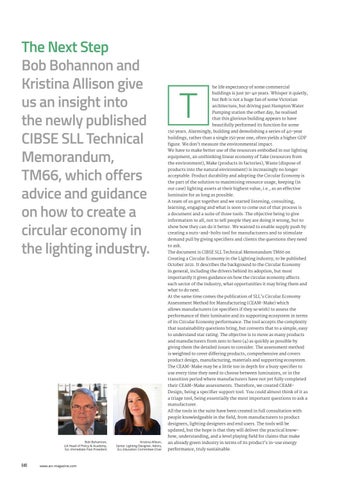The Next Step Bob Bohannon and Kristina Allison give us an insight into the newly published CIBSE SLL Technical Memorandum, TM66, which offers advice and guidance on how to create a circular economy in the lighting industry.
T
he life expectancy of some commercial
buildings is just 30-40 years. Whisper it quietly, but Bob is not a huge fan of some Victorian
architecture, but driving past Hampton Water Pumping station the other day, he realised that this glorious building appears to have
beautifully performed its function for some
150 years. Alarmingly, building and demolishing a series of 40-year
buildings, rather than a single 150 year one, often yields a higher GDP figure. We don’t measure the environmental impact.
We have to make better use of the resources embodied in our lighting equipment, an unthinking linear economy of Take (resources from the environment), Make (products in factories), Waste (dispose of products into the natural environment) is increasingly no longer
acceptable. Product durability and adopting the Circular Economy is the part of the solution to maximising resource usage, keeping (in our case) lighting assets at their highest value, i.e., as an effective luminaire for as long as possible.
A team of us got together and we started listening, consulting,
learning, engaging and what is soon to come out of that process is a document and a suite of three tools. The objective being to give
information to all, not to tell people they are doing it wrong, but to
show how they can do it better. We wanted to enable supply push by creating a nuts-and-bolts tool for manufacturers and to stimulate
demand pull by giving specifiers and clients the questions they need to ask.
The document is CIBSE SLL Technical Memorandum TM66 on
Creating a Circular Economy in the Lighting industry, to be published October 2021. It describes the background to the Circular Economy in general, including the drivers behind its adoption, but most
importantly it gives guidance on how the circular economy affects
each sector of the industry, what opportunities it may bring them and what to do next.
At the same time comes the publication of SLL’s Circular Economy Assessment Method for Manufacturing (CEAM-Make) which
allows manufacturers (or specifiers if they so wish) to assess the
performance of their luminaire and its supporting ecosystem in terms of its Circular Economy performance. The tool accepts the complexity
that sustainability questions bring, but converts that to a simple, easy to understand star rating. The objective is to move as many products and manufacturers from zero to hero (4) as quickly as possible by
giving them the detailed issues to consider. The assessment method is weighted to cover differing products, comprehensive and covers
product design, manufacturing, materials and supporting ecosystem. The CEAM-Make may be a little too in depth for a busy specifier to use every time they need to choose between luminaires, or in the
transition period where manufacturers have not yet fully completed their CEAM-Make assessments. Therefore, we created CEAM-
Design, being a specifier support tool. You could almost think of it as a triage tool, being essentially the most important questions to ask a manufacturer.
All the tools in the suite have been created in full consultation with people knowledgeable in the field, from manufacturers to product designers, lighting designers and end users. The tools will be
updated, but the hope is that they will deliver the practical know-
how, understanding, and a level playing field for claims that make Bob Bohannon, LIA Head of Policy & Academy, SLL Immediate Past President
048
www.arc-magazine.com
Kristina Allison, Senior Lighting Designer, Atkins, SLL Education Committee Chair
an already green industry in terms of its product’s in-use energy performance, truly sustainable.
